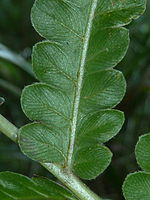Cyclosorus interruptus
| Cyclosorus interruptus | |
|---|---|

| |
| Scientific classification | |
| Kingdom: | Plantae |
| Clade: | Tracheophytes |
| Division: | Polypodiophyta |
| Class: | Polypodiopsida |
| Order: | Polypodiales |
| Suborder: | Aspleniineae |
| Family: | Thelypteridaceae |
| Genus: | Cyclosorus |
| Species: | C. interruptus |
| Binomial name | |
| Cyclosorus interruptus | |
| Synonyms | |
| |
Cyclosorus interruptus, the Hottentot fern[1] or swamp shield-fern, is a fern in the family Thelypteridaceae. It is native to the tropics and subtropics in many parts of the world.[2] In the New World, it is found from Mexico to Argentina, and in the Antilles.[3] In the Old World, it is found in India, China, Malaysia, Sri Lanka[4] and South Africa. It is also found in Australia, New Zealand, Hawaii and other islands in the Pacific Ocean. The various populations differ with respect to genetic cytotypes, glands, pubescence, and frond size.[3] Its habitat is the vicinity of freshwater swamps and it may reach 1 m (3 ft 3 in) in height.
History

In 1770 during the first voyage of James Cook, it was collected by Joseph Banks and Daniel Solander not far from Botany Bay.[5] Despite urbanization, it still occurs in a park in the Sydney bayside suburb of Monterey. The specific epithet interruptus is from the Latin, and refers to the sori.[6] The sori are in zig-zag rows or a v-shaped series along the frond margins, and are protected by a hairy, round or kidney shaped indusium.[7]
This plant appeared first appeared in the scientific literature as Pteris interrupta in 1794, published by the German taxonomist Carl Ludwig Willdenow. In 1810, it also appeared in the Prodromus Florae Novae Hollandiae as Nephrodium propinquum, authored by the prolific Scottish botanist Robert Brown. However, this plant has undergone considerable review, name changes, and taxonomic debate.[8]
Cultivation
C. interruptus is likely to be a useful landscape plant if kept damp and in gardens free of frost.[9] There are reports that the rhizome is edible.[6]
Uses as herbal medicine
C. interruptus is used in herbal medicine for sores, liver diseases, gonorrhea, cough, and malaria.[10]
References
- ^ a b Beentje, H.J. (2018). "Cyclosorus interruptus". IUCN Red List of Threatened Species. 2018: e.T164350A120230697. doi:10.2305/IUCN.UK.2018-2.RLTS.T164350A120230697.en. Retrieved 20 November 2021.
- ^ Bostock, Peter D. (1998). Flora of Australia. Vol. 48. CSIRO.
- ^ a b Smith, Alan R. "Thelypteris interrupta (Willdenow) K. Iwatsuki [family THELYPTERIDACEAE]". JSTOR Global Plants. Flora of North America, Vol 2. Retrieved 9 January 2015.
- ^ "San Diego Fern Society".
- ^ "Doug Benson and Georgina Eldershaw. Backdrop to encounter: the 1770 landscape of Botany Bay,the plants collected by Banks and Solander and rehabilitation of natural vegetation at Kurnell".
- ^ a b Les Robinson - Field Guide to the Native Plants of Sydney, ISBN 978-0-7318-1211-0 page 320
- ^ Native Plants of the Sydney District - Alan Fairley & Philip Moore ISBN 0-7318-1031-7, page 40
- ^ "Cyclosorus interruptus - Australian Plant Name Index".
- ^ "San Diego Fern Society".
- ^ Oyen LPA (2010) Cyclosorus interruptus (Willd.) H.Itô. Prota 16: Fibres/Plantes à fibres, eds Brink M & Achigan-Dako EG (PROTA, Wageningen, Netherlands.).
External links
![]() Media related to Cyclosorus interruptus at Wikimedia Commons
Media related to Cyclosorus interruptus at Wikimedia Commons

